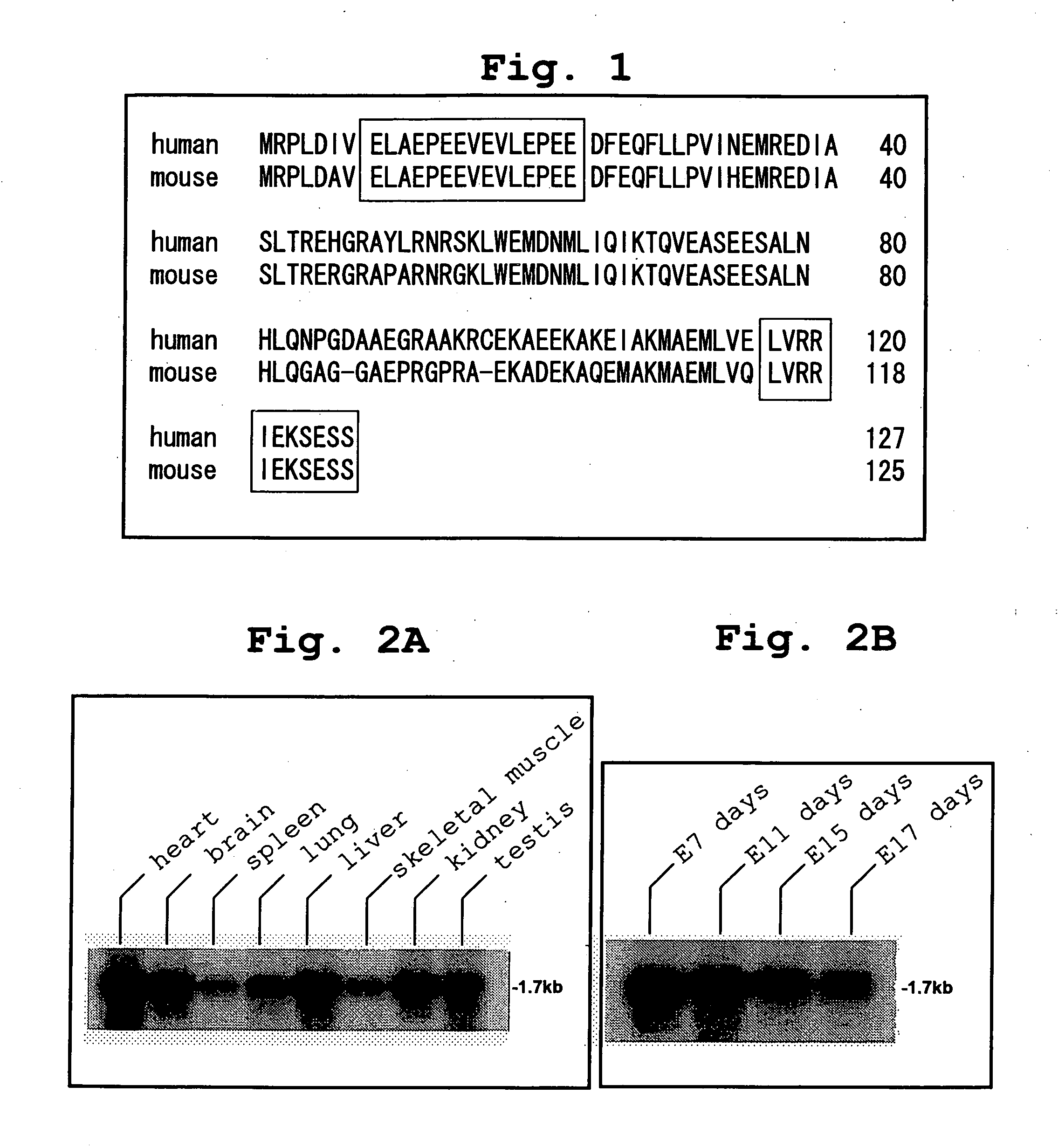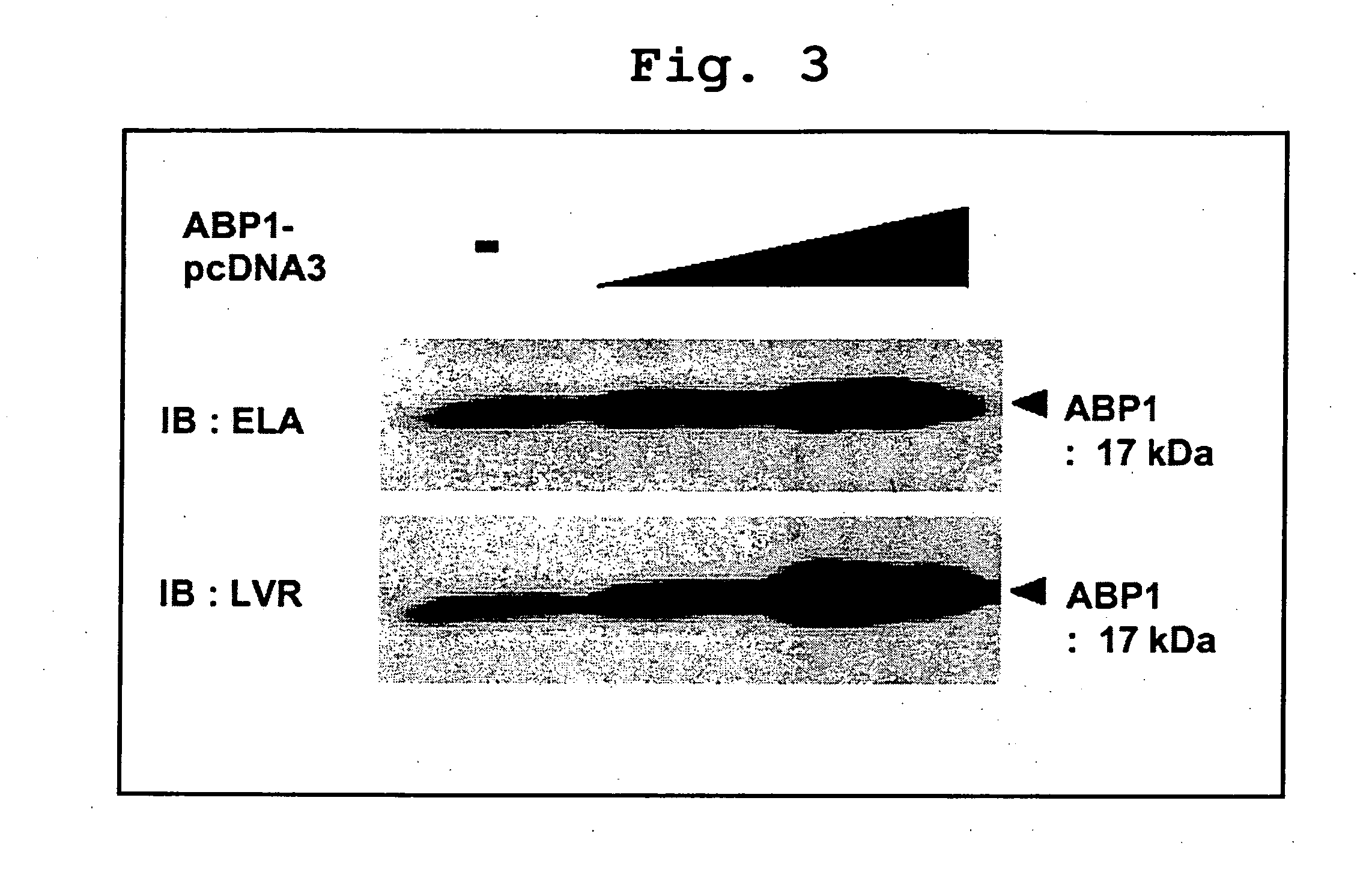Apoptosis-associated protein and use thereof
a technology of apoptosis and a protein, applied in the field of functional fragments of proteins, can solve the problems of abnormal proliferation of cells, various diseases, and possible aggravating factors of various diseases, and achieve the effects of suppressing apoptosis or inflammatory cytokine production, and reducing the expression or activity of a protein
- Summary
- Abstract
- Description
- Claims
- Application Information
AI Technical Summary
Problems solved by technology
Method used
Image
Examples
example 1
Cloning of ABP1 cDNA
[0396] To identify the ASK1-binding protein, screening was conducted by the yeast two-hybrid method using Brent's system [Zervos et al., Cell, Vol. 72, p. 223-232, 1993; Gyuris et al., Cell, Vol. 75, p. 791-803, 1993] with ASK1-KR, prepared by replacing lysine (K) at the ATP-binding site (position 709) in the kinase domain of human ASK1 with arginine (R), as a bait and an expression library of fetal human brain origin as a prey. As a result, about 1200 positive clones were obtained. Database search of one of them based on its base sequence identified it as a portion of the protein coding region of the gene designated as “PGR1” (a portion corresponding to amino acid positions 35 to 127). The protein encoded by this gene consists of 127 amino acids, but information on the database was only relevant to the structure of the gene, and did not contain a report on its function. Hence, the full-length cDNA that encodes the protein of this gene was cloned by the PCR meth...
example 2
Expression Distribution of ABP1 mRNA
[0397] Using Mouse (#7762-1) and Mouse Embryo (#7763-1) in the Multiple Tissue Northern Blot (CLONTECH) with the full-length human ABP1 cDNA as a probe, Northern blot was conducted as directed in the instruction manual of the above-described product. As a result, the length of the ABP1 mRNA was determined to be about 1.7 kb, and the mRNA was ubiquitously expressed throughout all tissues (FIG. 2A). Fetal mouse blot also revealed the expression of ABP1 mRNA from relatively early time of E7 days, with no major changes during the course of embryogenesis (FIG. 2B).
example 3
Production of ABP1 Protein in Various Animal Cells
[0398] Next, a rabbit polyclonal antibody against ABP1 was prepared. Two kinds of peptide antibodies were prepared with ABP1-specific peptide (SEQ ID NO:5 and SEQ ID NO:6) as antigens on the basis of amino acid sequence information from the base sequence of the ABP1 cDNA, and were designated as ELA antibody and LVR antibody, respectively. The two antibodies were both used after being purified on the basis of affinity for antigen peptide.
[0399] HeLa cells and HEK293 cells were cultivated in the presence of 5% CO2 using Dulbecco's modified Eagle medium.
[0400] (DMEM; SIGMA) containing a high concentration of glucose (4.5 mg / ml) as a culture medium. The culture medium was supplemented with 10% fetal bovine serum (FBS) and 100 Units / ml penicillin. Porcine aortic endothelial (PAE) cells were cultivated using an F12 culture medium (Invitrogen) supplemented with 10% FBS, 10 mM HEPES, and 100 Units / ml penicillin.
[0401] Each cell was lysed...
PUM
 Login to View More
Login to View More Abstract
Description
Claims
Application Information
 Login to View More
Login to View More - R&D
- Intellectual Property
- Life Sciences
- Materials
- Tech Scout
- Unparalleled Data Quality
- Higher Quality Content
- 60% Fewer Hallucinations
Browse by: Latest US Patents, China's latest patents, Technical Efficacy Thesaurus, Application Domain, Technology Topic, Popular Technical Reports.
© 2025 PatSnap. All rights reserved.Legal|Privacy policy|Modern Slavery Act Transparency Statement|Sitemap|About US| Contact US: help@patsnap.com



